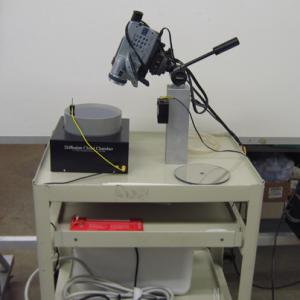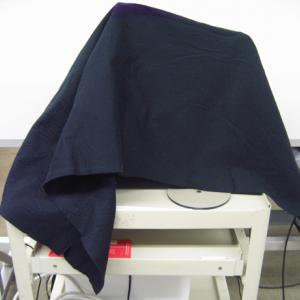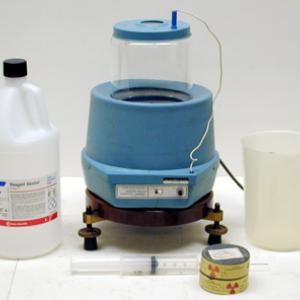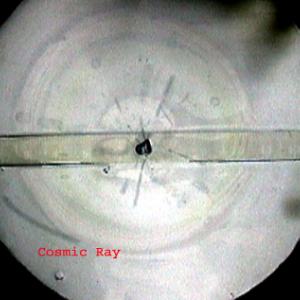College of Liberal Arts & Sciences
7D30.60 - Cloud Chamber
The large cloud chamber (Saturated Environments Unit) allows for a very large field of view and a way to quickly insert different samples. The four samples we commonly have available are: Pitchblende Ore (Radium 226 - Alpha Emitter), Pb 210 - Alpha Emitter, TIG welding Rod - 2% Thorium, and atmosphere that has been irradiated with a Thorium lantern mantle (Coleman Lantern Style) - which is the lantern mantle in the 60 CC syringe unit. Fill the 4 aluminum pans under the chamber with liquid nitrogen and then place the chamber onto this making sure the bottom plate of the chamber is in contact with the aluminum pans. Use 1 liter of alcohol to saturate the felt that is around the top of the unit. Pour any remaining alcohol directly into the chamber so that the whole bottom of the chamber is covered with a layer of liquid. Once this is done, it will take about 5 minutes for tracks to start appearing in the chamber. Cosmic rays will be viewable at all times. The desired samples can be inserted and secured in the side of the chamber with the insertion port. You may need to level the chamber with the leveling legs if the alcohol liquid is not evenly distributed in the bottom of the chamber during long runs.
The new chamber (A. U. Physics Enterprises) can be run using only ice and water. Put 8 liters of ice from the ice machine on 2nd floor into the Styrofoam container on the shelf below the chamber, add a little water, and turn on the pump. Add some alcohol to the bottom of the chamber and also wet the paper lining the sides of the chamber. Plug in the high voltage lead. Let the pump circulate water through the chamber for 20 minutes for good viewing of tracks.
The old chamber (Sargent-Welch) should be set up as described in the manual in the file. Care should be taken to insure that the black plate in the chamber is level. The chamber is attached to a leveling stand with Velcro so that this may be done. Turn the fluorescent light on as soon as possible or the ballast may get to cold to activate. Place the camera as shown over the glass window in the top plate. Close-up lenses are not needed if you use the macro part of the lens on the camera. The ion trails should appear in 5 to 15 minutes after the final step of activation and last for several hours.
- Matthew Geske, Crystal Murray-Weston, Graham Lelack, "Measuring Atmospheric Radon Levels Using a Cloud Chamber", TPT, Vol. 60, #6, Sept. 2022, p. 498.
- Le Ahn Duc, Nguyen Minh Duy, Nguyen Quoc B, Tran Ngoc Chat, Nguyen Ngoc Hung, "Improving the Wilson Cloud Chamber Using Peltier Chips", TPT, Vol. 60, #1, Jan. 2022, p. 62.
- Jason Cassidy, "Video Analysis of Cloud Chamber Phenomena", TPT, Vol. 32, #2, Feb. 1994, p. 124.
- A. C. Anderson, "Nature's Cloud Chamber", TPT, Vol. 13, #7, Oct. 1975, p. 424.
- Jared A. Ketner, "An Inexpensive Diffusion Cloud Chamber", TPT, Vol. 3, #6, Sept. 1965, p. 284.
- Elmer L. Galley, "An Inexpensive Continuous Cloud Chamber", TPT, Vol. 1, #2, May 1963, p. 80.
- Andrew B. Archer and Robert C. Amme, "A L-N2 Cooled Diffusion Cloud Chamber", AJP, Vol. 59, #3, Mar. 1991, p. 285.
- Haym Kruglak and Don Kangas, "A Simple Cloud Chamber for Television Display", AJP, Vol. 54, #5, May 1986, p. 473.
- Roger H. Stuewer, "The Naming of the Deuteron", AJP, Vol. 54, #3, Mar. 1986, p. 206.
- Robert L. Dough and Guenter Schwarz, "Cloud-Chamber Accessories", AJP, Vol. 35, #5, May 1967, p. ix.
- Juan G. Roederer, "Early Cosmic Ray Research in Argentina", Physics Today, Vol. 56, #1, Jan. 2003, p. 32.
- U. Schotzig, K. Debertin, "Photon Emmision Probabilities per Decay of 226Ra and 232Th in Equilibrium with Their Daughter Products", International Journal of Applied Radiation and Isotopes, Vol. 34, #2, Feb. 1983, p. 533.
- Sarah Charley, "How To Build Your Own Particle Detector", Popular Science, Vol. 287, #6, June 2015, p. 65.
- C. L. Stong, "The Amateur Scientist: How to Fit a Diffusion Cloud-Chamber with a Magnet and Other Accessories", Scientific American, Vol. 200, #6, June 1959, p. 173.
- C. L. Stong, "The Amateur Scientist: More about Making a Cloud Chamber to Reveal the Paths of Nuclear Particles", Scientific American, Vol. 194, #4, Apr. 1956, p. 156.
- D. Rae Carpenter Jr. and Richard B. Minnix, "S-140. Cloud Chamber", DICK and RAE Physics Demo Notebook, 1993.
- G. D. Freier and F. J. Anderson, "Hl-12. Wilson Cloud Chamber", A Demonstration Handbook for Physics.
- "Make Your Own Cloud Chamber", Popular Mechanics: The Boy Scientist, p. 192 - 193.
- Robert L. Wild, "179. Continuously Acting Cloud Chamber", Low-Cost Physics Demonstrations, p. 79 & 99.
- Joey Green, "Cosmic Ray Detector", The Mad Scientist Handbook, p. 13 - 15.
- Tom Petruzzellis, "Fun With a Cloud Chamber", Electronic Sensors for the Evil Genius, p. 248 - 251.
- C. J. Overback, R. R. Palmer, R. J. Stephenson, and Marsh W. White, "Emission Characteristics of Alpha Particles", Selective Experiments in Physics, CENCO, 1962.
- W. Bolton, "37. The Scattering of Alpha Particles", Book 3 - Atomic Physics, Physics Experiments and Projects, 1968, p. 81 - 82.
- W. Bolton, "12. The Expansion Cloud Chamber", Book 3 - Atomic Physics, Physics Experiments and Projects, 1968, p. 33 - 34.
- W. Bolton, "11. The Continuous Cloud Chamber", Book 3 - Atomic Physics, Physics Experiments and Projects, 1968, p. 30 - 32.
- Brian Carusella, "Cloud Chamber/Cosmic Ray Detector", Bizzare Stuff.
- Jerry DiMarco, James Papp, and Michael Timmins, "Mechanically Cooled Cloud Chamber", Tap-L Discussion, 07/01/2005.
- "Instructions Manual Cat. No. 2195 Cloud Chamber", The Welch Scientific Company, 1965.
- "Instructions Manual for the Model 500 and 600 Cloud Chamber", A. U. Physics Enterprises, 2009. Andrews University, Berrien Springs, MI 49104
- Sean P. Robinson, How to build a reliable "Homemade Cloud Chamber". (See the pdf files).
Disclaimer: These demonstrations are provided only for illustrative use by persons affiliated with The University of Iowa and only under the direction of a trained instructor or physicist. The University of Iowa is not responsible for demonstrations performed by those using their own equipment or who choose to use this reference material for their own purpose. The demonstrations included here are within the public domain and can be found in materials contained in libraries, bookstores, and through electronic sources. Performing all or any portion of any of these demonstrations, with or without revisions not depicted here entails inherent risks. These risks include, without limitation, bodily injury (and possibly death), including risks to health that may be temporary or permanent and that may exacerbate a pre-existing medical condition; and property loss or damage. Anyone performing any part of these demonstrations, even with revisions, knowingly and voluntarily assumes all risks associated with them.



